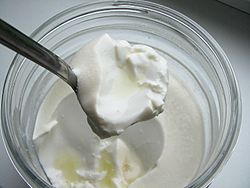Clabber (food) facts for kids
 |
|
| Main ingredients | Milk |
|---|---|
Clabber is a special kind of soured milk. It's made by letting milk that hasn't been pasteurized (heated to kill germs) naturally turn sour. This happens when the milk sits at a certain temperature and humidity. Over time, the milk gets thick and lumpy, a bit like yogurt, and it has a strong, sour taste.
In the past, especially in country areas of the Southern United States, people often ate clabber for breakfast. They would add things like brown sugar, nutmeg, cinnamon, or molasses to make it sweeter. Some also enjoyed it with fruit or even black pepper and cream. Before baking powder became popular, clabber was used in baking to help dough rise quickly. Because it didn't need a fridge to stay good, clabber was very useful in places without steady refrigeration.
The Story of Clabber
Clabber was brought to the Southern United States by a group of people called the Ulster Scots. They were settlers who moved to the Appalachian Mountains. Sometimes, clabber is still called bonny clabber. This name comes from old Gaelic words: bainne (which means milk) and clábair (which means sour milk).
Long ago, clabber was sometimes served with a special spoon. This spoon had its handle bent at a 90-degree angle from the bowl. This design made it easier to scoop the thick clabber out of the container where it had formed.
When pasteurization became common, making clabber at home almost stopped. This was because pasteurized milk doesn't sour in the same way. Today, you mostly find clabber on farms where fresh, unprocessed cow's milk is easy to get. You can also make something similar from pasteurized milk by adding a couple of spoonfuls of store-bought buttermilk or sour milk to it.
Foods Like Clabber
Many cultures around the world have foods similar to clabber. These are also made from milk that has been allowed to sour and thicken. Some examples include:

